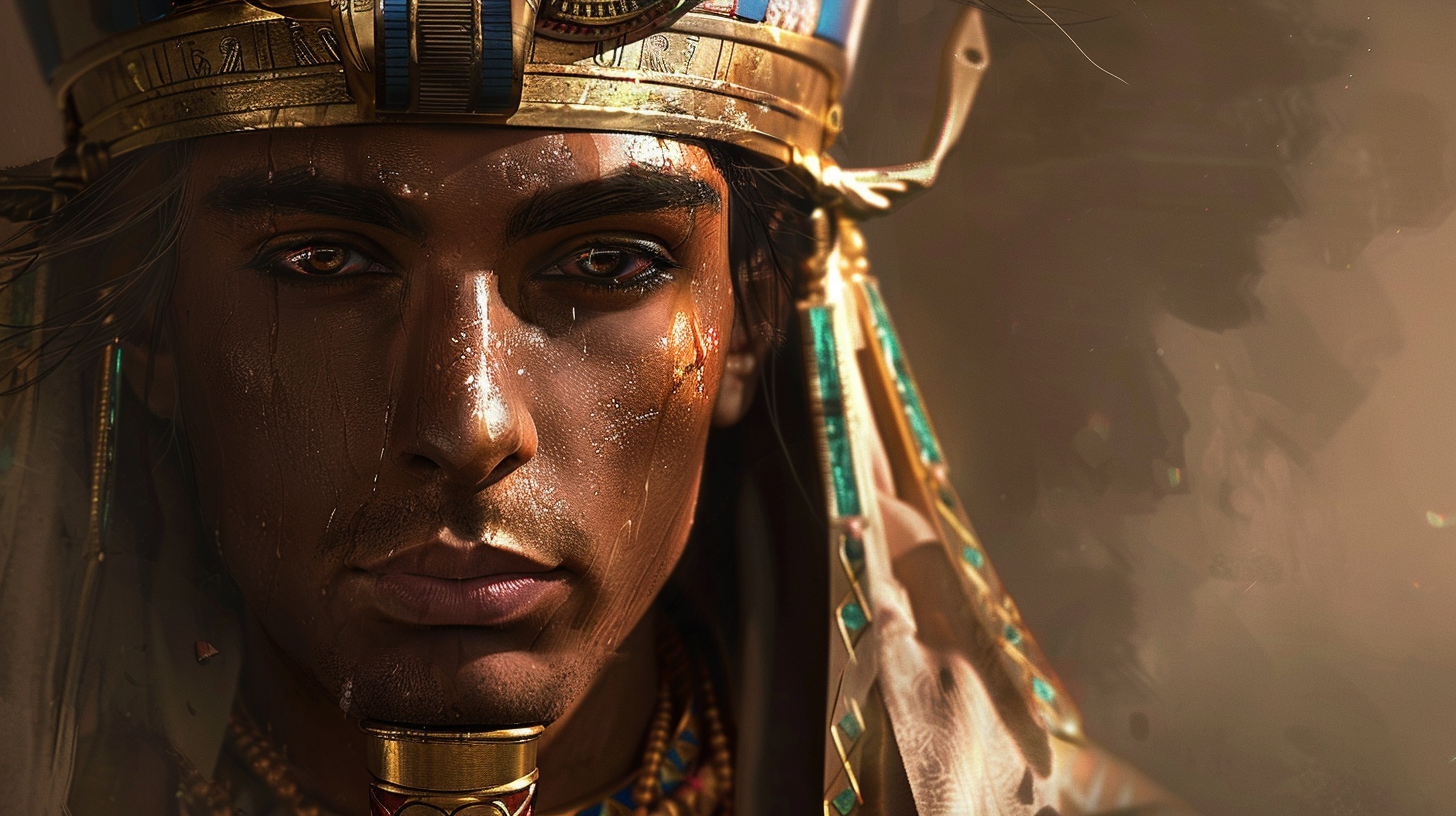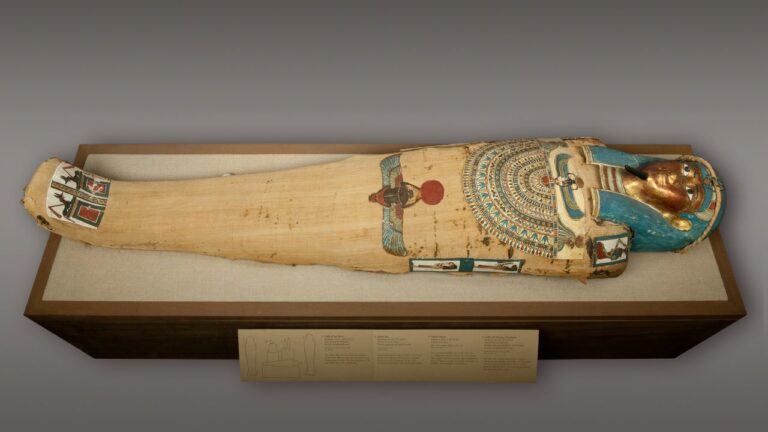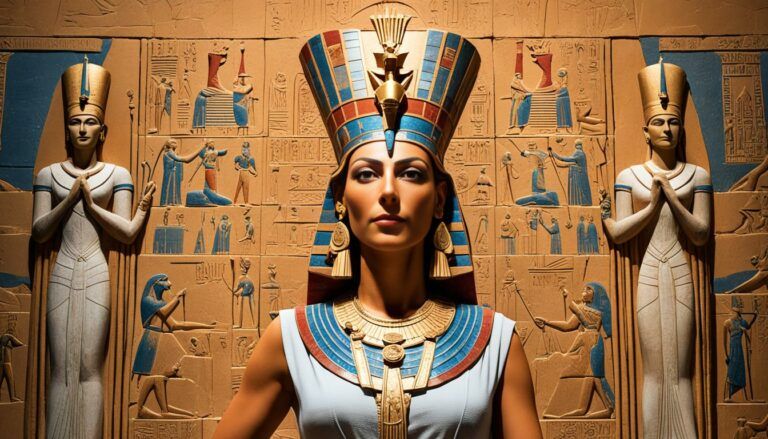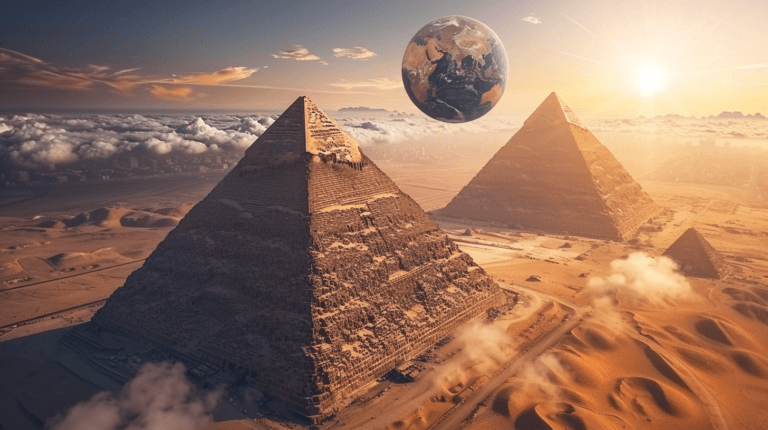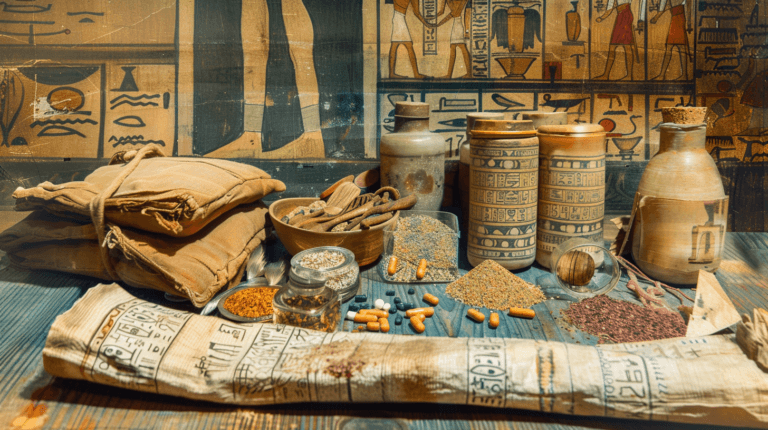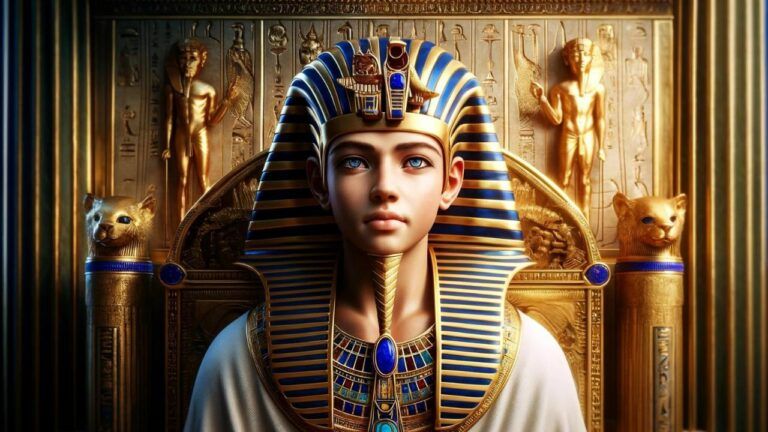Pharaoh Khufu – The Great Pyramid Builder
Did you know that the Great Pyramid of Giza, built by Pharaoh Khufu, is the largest pyramid in Egypt and one of the Seven Wonders of the Ancient World? This architectural marvel stands as a testimony to the ancient Egyptian ruler’s ambition and the incredible ingenuity of the civilization he ruled over.
Pharaoh Khufu, also known as Cheops, was the second pharaoh of the Fourth Dynasty of Egypt. His reign, which occurred approximately in the 26th century BC during the Old Kingdom period, remains shrouded in mystery. Despite the limited information available, his legacy as a great pyramid builder and the impact of the Great Pyramid on ancient Egyptian civilization are widely recognized.
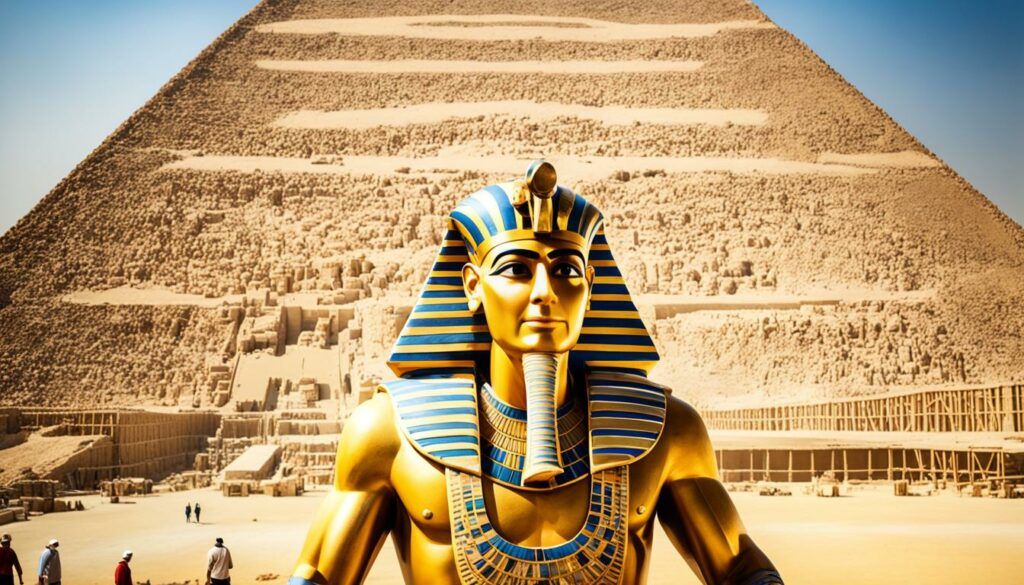
Key Takeaways:
- Pharaoh Khufu, also known as Cheops, was the second pharaoh of the Fourth Dynasty of Egypt.
- The Great Pyramid of Giza, built by Khufu, is the largest pyramid in Egypt and one of the Seven Wonders of the Ancient World.
- Khufu’s reign occurred in the 26th century BC during the Old Kingdom period.
- Despite limited information about Khufu’s reign, his legacy as a great pyramid builder is widely recognized.
- The Great Pyramid of Giza stands as a testament to Khufu’s ambition and the ingenuity of ancient Egyptian civilization.
The Legacy of Pharaoh Khufu as the Ancient Egyptian Ruler
Pharaoh Khufu’s legacy as an ancient Egyptian ruler is primarily reflected in the construction of the Great Pyramid of Giza. This monumental structure stands as a testament to his power and ambition, showcasing the remarkable architectural and engineering prowess of the time. Khufu’s reign marked a period of stability in Egypt, emphasizing the central authority of the pharaoh and his influence on the country’s political and cultural landscape.
While historical accounts of Khufu’s character vary, his achievements in pyramid building and the cultural significance of the Great Pyramid cannot be denied. As one of the Seven Wonders of the Ancient World, the Great Pyramid has captivated people for centuries, attracting scholars, explorers, and tourists from around the globe. Its sheer size and precision are a testament to the ingenuity and resourcefulness of ancient Egyptian civilization, with Pharaoh Khufu at the helm of this extraordinary feat.
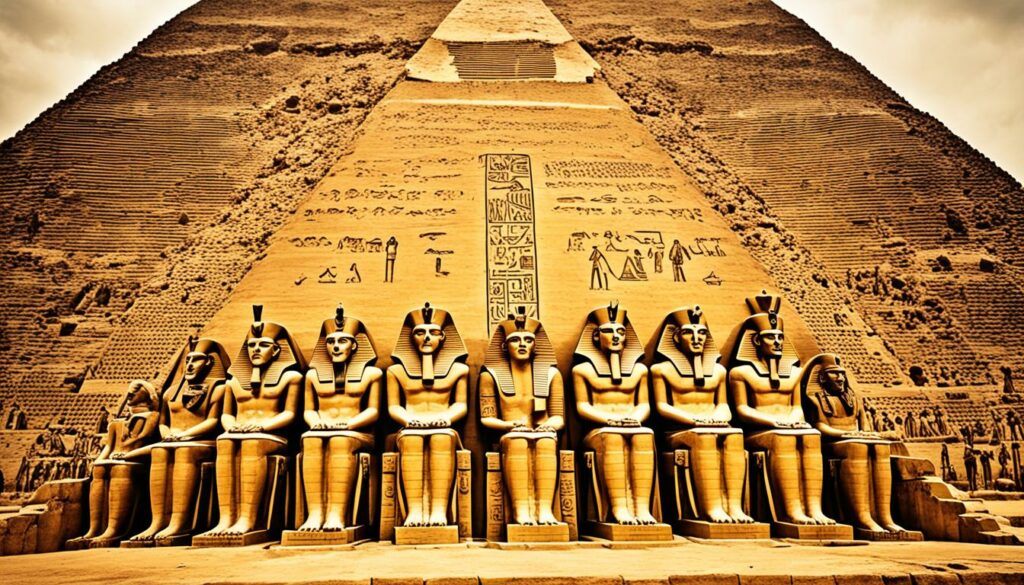
Architectural Marvel: Detailing the Great Pyramid of Giza
The Great Pyramid of Giza, standing as the largest and most renowned pyramid in Egypt, is a testament to the architectural mastery of ancient civilizations. This awe-inspiring monument required the use of intricate construction techniques and meticulous organization.
Construction Techniques and Organization
The precise methods employed in building the Great Pyramid of Giza continue to baffle historians and archaeologists. The sheer size and complexity of the structure, along with the limited technological resources available at the time, make its construction an engineering marvel.
Some theories suggest that the pyramids were built using simple tools and an immense workforce, while others propose the use of ramps or even advanced levitation techniques. The true construction techniques employed in building the Great Pyramid remain a subject of ongoing speculation and research.
The Magnificent Pyramid Complex
The Great Pyramid is not an isolated structure but part of a larger complex that includes various temples and other edifices. These additional structures were built to serve religious and ceremonial purposes, showcasing the importance of the pyramid in ancient Egyptian society.
Within the complex, there are temples dedicated to the Pharaoh and the worship of various Egyptian gods. These structures provide insights into the religious and cultural practices of the time, offering a glimpse into the ancient world.
Interior Chambers and Corridors
Inside the Great Pyramid, visitors can explore a network of chambers and corridors, each serving a unique purpose. The most famous of these is the King’s Chamber, believed to be the final resting place of Pharaoh Khufu himself.
An equally remarkable feature is the Grand Gallery, a long, sloping corridor that leads to the King’s Chamber. The precision in the design and construction of these interior spaces showcases the advanced architectural knowledge and attention to detail of the ancient Egyptians.

The Great Pyramid of Giza continues to captivate visitors and researchers alike, leaving them in awe of the incredible achievements of the ancient world. The mysterious techniques used in its construction, the impressive pyramid complex, and the intricate interior chambers are a testament to the enduring legacy of this architectural marvel.
Pharaoh Khufu and the Great Pyramid: A Testimony to Ancient Wonders
The Great Pyramid of Giza, built by Pharaoh Khufu, is hailed as one of the Seven Wonders of the Ancient World. This architectural marvel stands as a magnificent testament to the ingenuity and craftsmanship of the ancient Egyptians. With its massive size, impeccable precision, and enduring longevity, the Great Pyramid continues to captivate and inspire visitors from around the globe.

As one gazes upon the towering structure, the immensity and sheer grandeur leave a lasting impression. The Great Pyramid is a true marvel, showcasing the remarkable achievements of the ancient Egyptian civilization. Its precise alignment with the cardinal directions, extraordinary mathematical calculations, and intricate construction techniques defy explanation even to this day.
The Great Pyramid is not merely an enormous stone structure but a living testament to the prowess of Egypt’s pharaohs and the unwavering dedication of their subjects. Throughout centuries, countless individuals have journeyed to behold this ancient wonder, marveling at its architectural brilliance and standing in awe of the historical significance it represents.
The Great Pyramid of Giza, constructed under the rule of Pharaoh Khufu, serves as a bridge between the past and the present, inviting us to delve into the mysteries and wonders of ancient Egypt. Its enduring legacy and enigmatic allure beckon the curious to explore the realms of history, archaeology, and human achievement. Join us as we embark on a journey through time, unraveling the captivating stories that lie within the hallowed walls of this majestic structure.
Khufu’s Impact on Tourism and Global Recognition
Khufu’s Great Pyramid has left an indelible mark on Egypt’s tourism industry, attracting millions of visitors from around the world each year. Its towering presence and historical significance have contributed to the country’s economy and cultural heritage.
The Great Pyramid, as one of the Seven Wonders of the Ancient World, holds immense allure for travelers seeking to unravel the mysteries of ancient Egypt. The awe-inspiring structure acts as a magnet, drawing tourists to the Giza Plateau in droves. Egypt’s tourism industry has flourished thanks to the global interest in Khufu’s monumental creation.
Visiting the Great Pyramid allows tourists to immerse themselves in the rich history and architectural splendor of ancient Egypt. Exploring the pyramid, marveling at its grandeur, and discovering the secrets it holds within its chambers is an unforgettable experience that continues to captivate visitors.
The millions of tourists who flock to Egypt in search of adventure and cultural enlightenment contribute significantly to the nation’s economy. The revenue generated from tourism supports various sectors, including hospitality, transportation, and local businesses, benefiting communities surrounding the archaeological site.
The Great Pyramid as an Iconic Historical Monument
The Great Pyramid of Khufu stands as a testament to human ingenuity and engineering prowess. Its construction, in alignment with the stars and precise alignments of the cardinal directions, showcases the advanced knowledge and skill of the ancient Egyptians.
“The Great Pyramid is a symbol of the extraordinary achievements of ancient Egypt, a testament to the unparalleled architectural sophistication and cultural significance of that civilization. It is a marvel of the ancient world that continues to astound and inspire visitors from all corners of the globe.”
– World-renowned archaeologist Dr. Zahi Hawass
Recognized worldwide, the Great Pyramid has become an iconic historical monument. It symbolizes the ancient Egyptian civilization and acts as a catalyst for intrigue and fascination with its mysteries. Its presence on the Giza Plateau cements Egypt’s reputation as a hub of historical wonders and entices travelers to explore the country’s rich past.
From its towering height to its meticulous construction, the Great Pyramid of Khufu is an enduring tribute to Pharaoh Khufu’s legacy and the ancient wonders of Egypt. Its impact on tourism and global recognition cannot be overstated, making it a must-visit destination for history enthusiasts and adventure-seekers alike.
The Influence on Tourism in Egypt
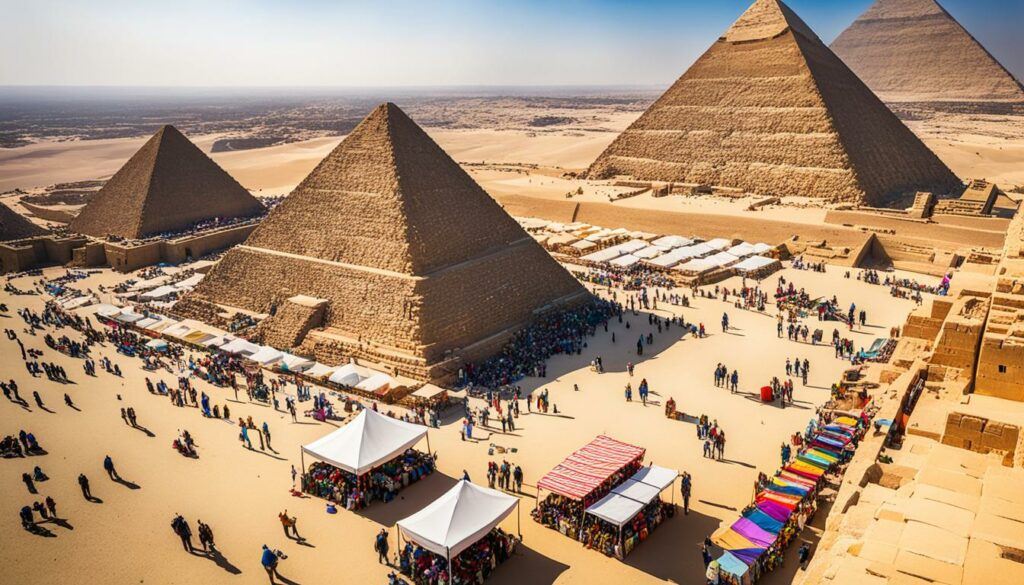
Analyzing Khufu’s Reign and Egypt’s Golden Era
Khufu’s reign is often associated with Egypt’s golden era, a time of great prosperity and cultural development. As the second pharaoh of the Fourth Dynasty, Khufu made significant contributions to ancient Egyptian history that continue to captivate scholars and historians today.
Comparison with Other Pharaohs and Dynasties
When comparing Khufu’s reign to other pharaohs and dynasties, it becomes evident that he played a pivotal role in shaping the political and cultural landscape of ancient Egypt. His legacy as a great pyramid builder and his advancements in architecture and engineering set him apart from his predecessors and successors.
During Khufu’s rule, ancient Egypt witnessed an unprecedented period of monumental construction. The Great Pyramid of Giza, his most significant achievement, stands as a testament to his vision and ambition. Its grandeur and precision continue to awe visitors from around the world.
In the context of other pharaohs and dynasties, Khufu’s reign represents a culmination of human achievement and ingenuity. The architectural marvels he left behind serve as a benchmark for future generations, showcasing the advanced knowledge and skills possessed by ancient Egyptians.
Myths vs. Historical Facts About King Khufu’s Rule
Throughout history, myths and legends have often surrounded influential figures like Khufu. It is essential to examine these stories in relation to historical facts to gain a comprehensive understanding of his reign and its significance.
One common myth about Khufu’s reign is the notion that the Great Pyramid was built by enslaved workers under harsh conditions. However, archaeological evidence suggests that the construction was a meticulously planned and organized endeavor, likely involving skilled laborers and significant resources provided by the state.
Another myth revolves around Khufu’s character, portraying him as a tyrannical ruler. While it is challenging to ascertain the exact nature of his rule, historical records suggest that Khufu’s reign was characterized by stability, central authority, and notable achievements.
To truly understand the impact of Khufu’s reign, it is crucial to separate fact from fiction, relying on the available historical evidence and expert analysis. By doing so, we can appreciate the remarkable achievements of Khufu and his contributions to Egypt’s golden era.
Conclusion
Pharaoh Khufu, also known as Cheops, left an indelible mark on the ancient world as the Great Pyramid builder and an influential ruler of Egypt. The construction of the Great Pyramid of Giza stands as a remarkable testament to the ingenuity and skill of the ancient Egyptians. This colossal structure continues to awe and inspire people from all corners of the globe.
Khufu’s reign marked a golden era in Egypt’s history, characterized by stability and cultural prosperity. The Great Pyramid is not simply a reflection of his power and ambition; it represents the pinnacle of architectural achievement in ancient Egypt.
Moreover, Khufu’s legacy extends beyond the realm of ancient history. The impact of the Great Pyramid on tourism in Egypt cannot be understated. It draws millions of visitors each year, contributing to the country’s economy and standing as an iconic symbol of ancient Egyptian civilization.
By examining the construction techniques of the Great Pyramid, exploring Khufu’s influence on tourism, and analyzing his reign in comparison to other pharaohs and dynasties, we gain a deeper understanding of the rich cultural heritage and historical significance of ancient Egypt. Pharaoh Khufu’s legacy endures as a testament to the remarkable achievements of one of the most fascinating civilizations in human history.
FAQ
Who was Pharaoh Khufu?
Pharaoh Khufu, also known as Cheops, was the second pharaoh of the Fourth Dynasty of Egypt and is best known for commissioning the construction of the Great Pyramid of Giza.
What is the Great Pyramid of Giza?
The Great Pyramid of Giza is the largest and most well-known pyramid in Egypt. It was built by Pharaoh Khufu and is considered one of the Seven Wonders of the Ancient World.
What is the significance of the Great Pyramid of Giza?
The Great Pyramid of Giza represents the architectural and engineering prowess of ancient Egypt. It stands as a testament to Pharaoh Khufu’s power, ambition, and the cultural significance of pyramid building in ancient Egyptian civilization.
How was the Great Pyramid of Giza constructed?
The construction of the Great Pyramid involved intricate techniques and organization. It encompasses not only the pyramid itself but also numerous other structures and temples. The precise construction methods used in building the pyramid continue to puzzle historians and archaeologists.
What is the impact of the Great Pyramid on tourism?
The Great Pyramid of Giza draws millions of visitors each year, contributing to Egypt’s economy and cultural heritage. It has become an iconic symbol of ancient Egyptian history and civilization, recognized worldwide as one of the most extraordinary architectural achievements in human history.
How does Pharaoh Khufu’s reign compare to other pharaohs and dynasties?
Comparisons between Khufu and other pharaohs and dynasties provide insights into the achievements and contributions of ancient Egyptian rulers. His reign is often associated with Egypt’s golden era, a time of great prosperity and cultural development.
Are there any myths or legends surrounding Pharaoh Khufu’s rule?
Yes, there are myths and legends surrounding Khufu’s rule. However, it is essential to examine them in relation to historical facts to gain a comprehensive understanding of his reign and its significance.

